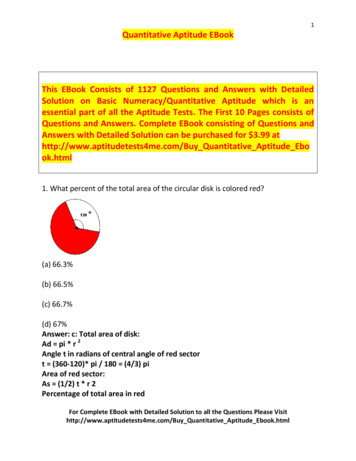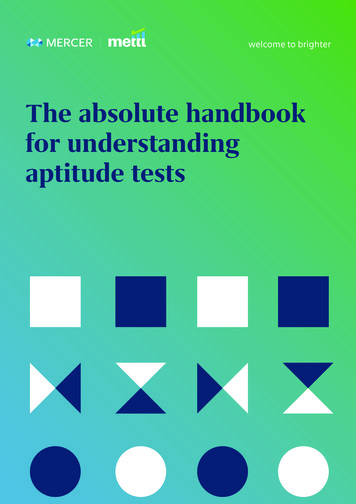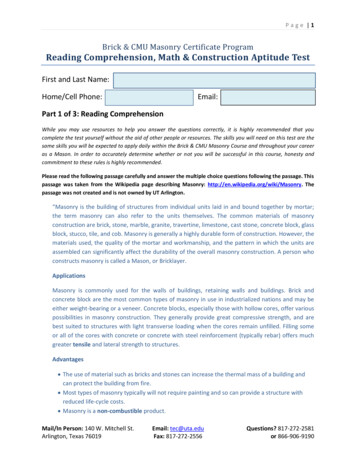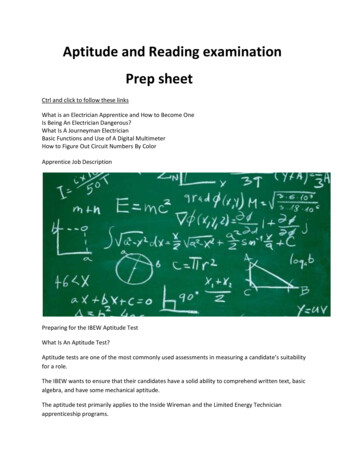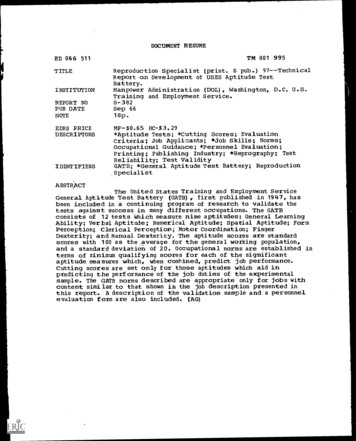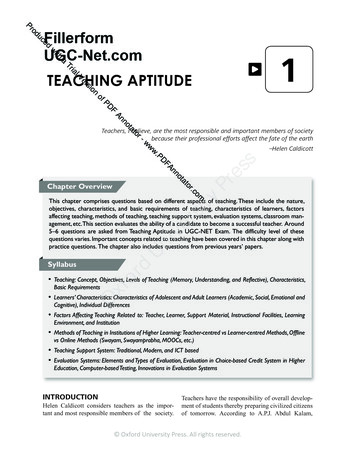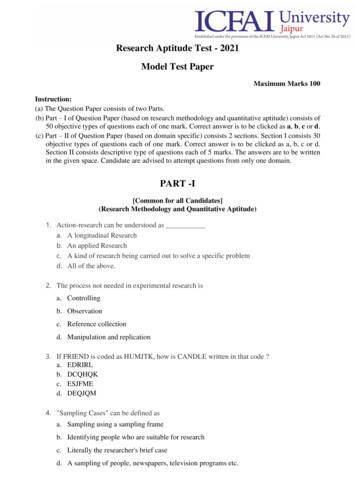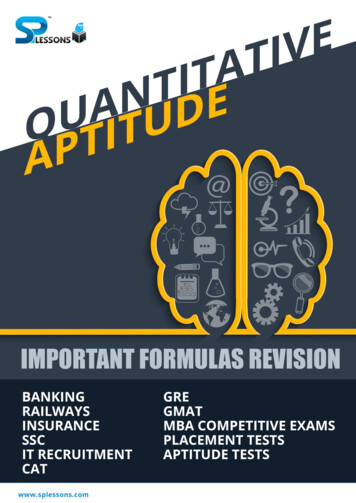
Transcription
Quantitative Aptitude Important Formulas Revision E-book
Quantitative Aptitude Important Formulas Revision E-bookStay Connected with SPNotifierEBooks for Bank Exams, SSC & Railways 2020General Awareness EBooksComputer Awareness EBooksMonthly Current Affairs Capsules
Quantitative Aptitude Important Formulas Revision E-bookQuantitative Aptitude Important Formulas RevisionIntroduction to Quantitative Aptitude:Quantitative Aptitude is an important section in the employment-related competitive exams in India.Quantitative Aptitude Section is one of the key sections in recruitment exams in India including but notlimited to Banking, Railways, and Staff Selection Commission, Insurance, Teaching, UPSC and manyothers. The Quantitative Aptitude section has questions related to Profit and Loss, Percentage andDiscount, Simple Equations, Time and Work and Quadratic Equations, Mensuration etc.SimplificationOne of the most common topic in quantitative aptitude section is simplification.1. 'BODMAS' Rule: This rule depicts the correct sequence in which the operations are to be executed, so as to find out thevalue of given expression.B - Bracket,O - of,D - Division,M - Multiplication,A - Addition andS - SubtractionThus, in simplifying an expression, first of all the brackets must be removed, strictly in the order (), {} and .After removing the brackets, one must use the following operations strictly in the tionSubtraction.Modulus of a Real Number: Modulus of a real number a is defined asa, if a 0 a -a, if a 0Thus, 5 5 and -5 -(-5) 5.
Quantitative Aptitude Important Formulas Revision E-book2.Virnaculum (or Bar): When an expression contains Virnaculum, before applying the 'BODMAS' rule, we simplify theexpression under the Virnaculum.Profit and LossCost Price (C.P.) is the price at which a buyer buys an article. Selling Price (S.P.) is the price at which a seller sells the article. Ifthe S.P. is greater than the C.P., the seller will have profit. Alternatively, if the S.P. is less than C.P., the seller will incur loss.Loss or gain is always reckoned on C.P.The following formula are essential to support the concept of profit and loss.1.Gain (S.P.) - (C.P.)2.Loss (C.P.) - (S.P.)3.Gain Percentage: (Gain %)Gain x 100Gain % C.P.4.Loss Percentage: (Loss %)Loss x 100Loss % C.P.5.Selling Price: (S.P.)(100 Gain %)SP x C.P1006.Selling Price: (S.P.)(100 - Loss %)SP x C.P.1007.Cost Price: (C.P.)100C.P. x S.P.(100 Gain %)8.Cost Price: (C.P.)100C.P. x S.P.(100 - Loss %)9.If an article is sold at a gain of say 35%, then S.P. 135% of C.P.
Quantitative Aptitude Important Formulas Revision E-book10. If an article is sold at a loss of say, 35% then S.P. 65% of C.P.11. When a person sells two similar items, one at a gain of say x%, and the other at a loss of x%, then the seller always incursa loss given by:Common Loss and Gain % 2x 2Loss % .101012. If a trader professes to sell his goods at cost price, but uses false weights, thenErrorGain % x 100%.(True Value) - (Error)Mixtures & Alligations1.Alligation: It is the rule that enables us to find the ratio in which two or more ingredients at the given price must bemixed to produce a mixture of desired price.2.Mean Price: The cost of a unit quantity of the mixture is called the mean price.3.Rule of Alligation: If two ingredients are mixed, thenQuantity of cheaperC.P. of dearer - Mean Price Quantity of dearerMean price - C.P. of cheaperWe present as under:C.P. of a unit quantity of cheaperC.P. of a unit quantity of dearer(c)(d)Mean Price(m)(d - m)(m - c)(Cheaper quantity) : (Dearer quantity) (d - m) : (m - c).4.Suppose a container contains x of liquid from which y units are taken out and replaced by water.y nAfter n operations, the quantity of pure liquid x 1 units.x
Quantitative Aptitude Important Formulas Revision E-bookComputation of Interest: Simple & CompoundThe money that someone borrows or lents out for a certain period is known as the principal amount. The extra money that theborrower pays the lender for using that money is known as the interest. This interest can be in the form of simple or compoundinterest.Simple interest is the interest on the sum borrowed for a certain period that is reckoned uniformly.Let Principal P, Rate R% per annum (p.a.) and Time T years. ThenPxRxT1.Simple Interest 100100 x S.I.2.P 100 x S.I.;R RxT100 x S.I.and T PxT.PxRCompound Interest is the addition of the interest to the principal sum. Therefore, if Principal P, Rate R% per annum,Time n years, then:1.When interest is compound Annually:RnAmount P 1 1002.When interest is compounded Half-yearly:(R/2) 2nAmount P 1 1003.When interest is compounded Quarterly:(R/4) 4nAmount P 1 1004.When interest is compounded Annually but time is in fraction, say 33RRAmount P 1 x 1 1005.years.100When Rates are different for different years, say R1%, R2%, R3% for 1st, 2nd and 3rd year respectively.
Quantitative Aptitude Important Formulas Revision E-bookR1Then, Amount PR21 1 1006.R31 100.100Present worth of Rs. x due n years hence is given by:xPresent Worth Rn1 100Surds & IndicesLaws of Indices:i.am x an am nii.am am - naniii.iv.(am)n amn(ab)n anbnv.a nan bvi.bna0 1Laws of Surds:Let a be rational number and n be a positive integer such that a(1/n) a. Then, a is called a surd of order n.vii.viii.a a(1/n)ab a x bix.a bx.(a)n axi.xii.(a)m am
Quantitative Aptitude Important Formulas Revision E-bookWork & Time1.Work from Days:1If A can do a piece of work in n days, then A's 1 day's work .n2.Days from Work:1If A's 1 day's work , then A can finish the work in n days.n3.Ratio:If A is thrice as good a workman as B, then:Ratio of work done by A and B 3: 1.Ratio of times taken by A and B to finish a work 1: 3.Time & Distance1. Speed, Time and Distance:DistanceSpeed , Time TimeDistance, Distance (Speed x Time).Speed2. km/hr to m/sec conversion:5x km/hr x xm/sec.183. m/sec to km/hr conversion:18x m/sec x xkm/hr.54. If the ratio of the speeds of A and B is a: b, then the ratio of the1 1the times taken by then to cover the same distance is :or b : a.a bNote: Suppose a man covers a certain distance at x km/hr and an equal distance at y km/hr. Then,the average speed during the whole journey is 2xy km/hr.
Quantitative Aptitude Important Formulas Revision E-bookx yRatio & Proportion1.𝑎Ratio: The ratio of two quantities a and b in the same units, is the fraction and we write it as a : b. In the ratio a: b, a is𝑏the first term or antecedent and b, is the second term or consequent.5Example: The ratio 5 : 9 representswith antecedent 5, consequent 9.9Rule: The multiplication or division of each term of a ratio by the same non-zero number does not affect the ratio.Example: 4: 5 8: 10 12: 15. Also, 4: 6 2: 3.2.Proportion: The equality of two ratios is called proportion. If a: b c: d, then write a: b:: c : d and a, b, c, d shall be inproportion.Here, a and d are called extremes, while b and c are called mean terms.Product of means Product of extremes.Thus, a : b :: c : d(b x c) (a x d).3.Fourth Proportional: If a: b c: d, then d is called the fourth proportional to a, b, c.Third Proportional: a: b c: d, then c is called the third proportion to a and b.Mean Proportional: Mean proportional between a and b is ab.4.Comparison of Ratios:ac(a : b) (c : d) .bd5.Compounded Ratio: The compounded ratio of the ratios: (a: b), (c: d), (e : f) is (ace : bdf).6.Duplicate Ratios:Duplicate ratio of (a: b) is (a2 : b2).Sub-duplicate ratio of (a: b) is (a: b).Triplicate ratio of (a: b) is (a3 : b3).Sub-triplicate ratio of (a: b) is (a1/3 : b1/3).aca bc dIf , then . [componendo and dividendo]bda-bc-d7.Variations: x is directly proportional to y, if x ky for some constant k and we write, xAlso, x is inversely proportional to y, if xy k for some constant k andy.
Quantitative Aptitude Important Formulas Revision E-book1.we write, xyPermutation, Combination1.Factorial Notation:Let n be a positive integer. Then, factorial n, denoted n! is defined as:n! n (n - 1) (n - 2) . 3.2.1.Examples:2.i.We define 0! 1.ii.4! (4 x 3 x 2 x 1) 24.iii.5! (5 x 4 x 3 x 2 x 1) 120.Permutations: The different arrangements of a given number of things by taking some or all at a time, are calledpermutations.Examples:i.All permutations (or arrangements) made with the letters a, b, c by taking two at a time are(ab, ba, ac, ca, bc, cb).All permutations made with the letters a, b, c taking all at a time are:( abc, acb, bac, bca, cab, cba).ii.3.Number of Permutations: Number of all permutations of n things, taken r at a time, is given by:n!nPr n(n - 1)(n - 2) . (n - r 1) (n - r)!Examples:6i.P2 (6 x 5) 30.7ii.P3 (7 x 6 x 5) 210.iii.Cor. number of all permutations of n things, taken all at a time n!4.An Important Result: If there are n subjects of which p1 are alike of one kind; p2 are alike of another kind; p3 are alike ofthird kind and so on and pr are alike of rth kind, such that (p1 p2 . pr) n.n!Then, number of permutations of these n objects is (p1!).(p2)!.(pr!)5.Combinations: Each of the different groups or selections which can be formed by taking some or all of a number ofobjects is called a combination.Examples:i.Suppose we want to select two out of three boys A, B, C. Then, possible selections are AB, BC and CA.
Quantitative Aptitude Important Formulas Revision E-bookii.Note: AB and BA represent the same selection.a. All the combinations formed by a, b, c taking ab, bc, ca.b. The only combination that can be formed of three letters a, b, c taken all at a time is abc.c.d.Various groups of 2 out of four persons A, B, C, D are: AB, AC, AD, BC, BD, CD.Note that ab ba are two different permutations but they represent the same combination.Number of Combinations: The number of all combinations of n things, taken r at a time is:n!n(n - 1)(n - 2) . to r factorsnCr .(r!)(n - r)!r!Note: nCn 1 and nC0 1. nCr nC (n - r)Examples:(11 x 10 x 9 x 8)11i. C4 330.(4 x 3 x 2 x 1)16 x 15 x 14ii.161616C13 C(16 - 13) C3 16 x 15 x 14 3! 560.3x2x1Probability1.Experiment: An operation which can produce some well-defined outcomes is called an experiment.2.Random Experiment: An experiment in which all possible outcomes are know and the exact output cannot be predictedin advance, is called a random experiment.Examples:i.Rolling an unbiased dice.ii.Tossing a fair coin.iii.Drawing a card from a pack of well-shuffled cards.iv.Picking up a ball of certain color from a bag containing balls of different colors.Details:a)When we throw a coin, then either a Head (H) or a Tail (T) appears.b) A dice is a solid cube, having 6 faces, marked 1, 2, 3, 4, 5, 6 respectively. When we throw a die, the outcome isthe number that appears on its upper face.c)A pack of cards has 52 cards. It has 13 cards of each suit, name Spades, Clubs, Hearts and Diamonds. Cards ofspades and clubs are black cards. Cards of hearts and diamonds are red cards. There are 4 honors of each unit.There are Kings, Queens and Jacks. These are all called face cards.
Quantitative Aptitude Important Formulas Revision E-book3.Sample Space: When we perform an experiment, then the set S of all possible outcomes is called the sample space.Examples:a.In tossing a coin, S {H, T}b.If two coins are tossed, the S {HH, HT, TH, TT}.c.In rolling a dice, we have, S {1, 2, 3, 4, 5, 6}.Event: Any subset of a sample space is called an event.Probability of Occurrence of an Event: Let S be the sample and let E be an event.Then, ES.n(E)P(E) .n(S)Results on Probability:i.P(S) 1ii.0iii.P( ) 0iv.v.For any events A and B we have : P(A B) P(A) P(B) - P(AIf A denotes (not-A), then P(A) 1 - P(A).P (E)1B)Mensuration1.CUBOID: Let length l, breadth b and height h units. Then,Volume (l x b x h) cubic units.Surface area 2(lb bh lh) sq. units.Diagonal l2 b2 h2 units.2.CUBE: Let each edge of a cube be of length a. Then,Volume a3 cubic units.Surface area 6a2 sq. units.Diagonal 3a units.3.CYLINDER: Let radius of base r and Height (or length) h. Then,Volume ( r2h) cubic units.Curved surface area (2 rh) sq. units.Total surface area 2 r(h r) sq. units.
Quantitative Aptitude Important Formulas Revision E-book4.CONE: Let radius of base r and Height h. Then,Slant height, l h2 r2 units.1Volume [ πr2h] cubic units.3Curved surface area (π rl) sq. units.Total surface area (π rl π r2) sq. units.5.SPHERE: Let the radius of the sphere be r. Then,4Volume [ π r3] cubic units.3Surface area (4 r2) sq. units.6.HEMISPHERE: Let the radius of a hemisphere be r. Then,2Volume [ π r3] cubic units.3Curved surface area (2 π r2) sq. units.Total surface area (3 π r2) sq. units.Note: 1 liter 1000 cm3.Number SeriesSome Basic Formulae:1.(a b) (a - b) (a2 - b2)2.(a b)2 (a2 b2 2ab)3.(a - b)2 (a2 b2 - 2ab)4.(a b c)2 a2 b2 c2 2(ab bc ca)5.(a3 b3) (a b) (a2 - ab b2)6.(a3 - b3) (a - b) (a2 ab b2)7.(a3 b3 c3 - 3abc) (a b c) (a2 b2 c2 - ab - bc - ac)8.When a b c 0, then a3 b3 c3 3abc.Partnership1.Partnership: When two or more than two persons run a business jointly, they are called partners and the deal is knownas partnership.2.Ratio of Divisions of Gains:I.When investments of all the partners are for the same time, the gain or loss is distributed among the partners in theratio of their investments.Suppose A and B invest Rs. x and Rs. y respectively for a year in a business, then at the end of the year:(A's share of profit): (B's share of profit) x: y.
Quantitative Aptitude Important Formulas Revision E-bookII.3.When investments are for different time periods, then equivalent capitals are calculated for a unit of time by taking(capital x number of units of time). Now gain or loss is divided in the ratio of these capitals.Suppose A invests Rs. x for p months and B invests Rs. y for q months then,(A's share of profit): (B's share of profit) xp : yq.Working and Sleeping Partners: A partner who manages the the business is known as a working partner and the one whosimply invests the money is a sleeping partner.Stay Connected with SPNotifier
Quantitative Aptitude Important Formulas Revision E-bookQuantitative Aptitude E-BooksReasoning Ability E-BooksEnglish Language E-Books
Quantitative Aptitude Important Formulas Revision E-book 2. Virnaculum (or Bar): When an expression contains Virnaculum, before applying the 'BODMAS' rule, we simplify the expression under the Virnaculum. Profit and Loss Cost Price (C.P.) is the price at which a buyer buys an article. Selling Price
